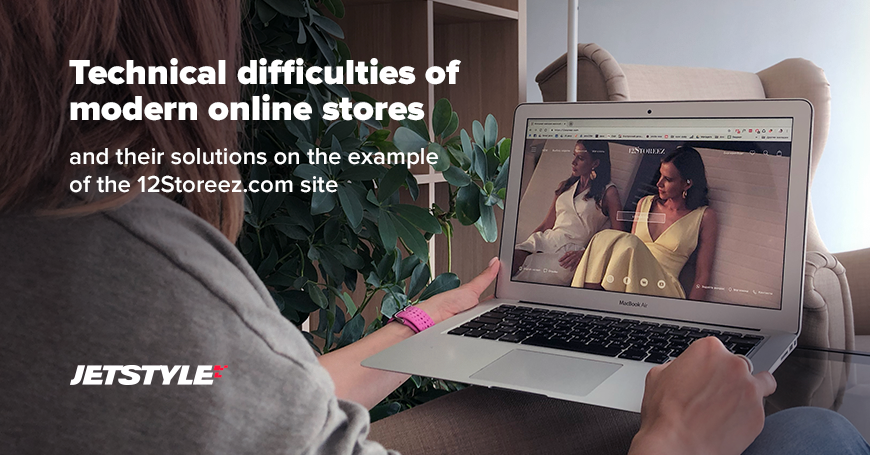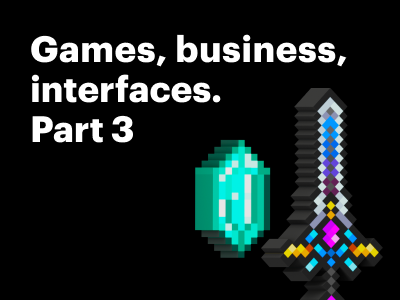18 July 2019
JetStyle: Technical difficulties of modern online stores and their solutions
Today we will talk about how we at JetStyle solved the old problems when developing the new website 12Storeez.com and how to create a competitive advantage using digital ecology.

You must have come across the opinion that if you are a small business, then a simple site made with a website builder is enough for you, and all these automations, synchronisation and complex architecture are a waste of time and money and you can do it when you become like Amazon.
In our opinion, this approach is really useful, but only at the stage of testing hypotheses. If the business is growing, scaling and gaining momentum, a few pages built on Tilda with a “buy now” button won't be enough.
Why? Everything is quite simple – the environment where competition is unfolding today is digital. Therefore, you will have to compete with the help of your digital infrastructure.
To come up with competitive advantages, integrate with new tools, enter new channels. In general, sooner or later you will have to use custom development when you need to design all the logic of the future product, including the implementation of business processes and solving complex technological problems.
We will show it on the example of an e-commerce project.
One of our clients is the Russian clothing brand 12Storeez, founded by twin sisters Marina and Irina Golomazdin and Ivan Khokhlov.
The peculiarity of the brand is that it releases one collection each month (hence the name: 12 months – 12 different stories). This business idea means a monthly update of collections on the site and peak loads on the day of their release.
The client came to us with an existing site and the problems that couldn't be solved by a simple upgrade. Therefore, we did everything from scratch, keeping in mind three main difficulties.
Problem 1. Sale of non-existent goods
On the old site, stock balances were only updated every 15 minutes. In times of peak sales, this speed was clearly not enough. A situation, when customers ordered and paid for goods on the site that were no longer in stock, occurred regularly.
In order to deal with overorders and refund money to customers, the company spent additional time and effort of their employees (which means lost profits and direct losses). The loyalty of customers who paid for goods, but never received them, predictably fell. Moreover, once in every 15 minutes, during website data synchronisation with 1C data, the menu on the site disappeared and it was impossible to make a purchase. This adversely affected conversion.
Our project manager Vladimir Stakheev tells what steps we have taken to solve problems with synchronisation of stock balances:
1. We completely stopped using the standard data exchange protocol with 1C (xml-files, exchange according to the regulations once every n minutes);
2. On the site side, we created a RESTful API and added a queue server;
3. 1C programmers from the client's side have finalised the system – it is now able to send data to the site's API, and they also set up a web service to receive data from the site:
- all changes in 1C are instantly sent to the site;
- all changes on the site are instantly sent to 1C through the queue server (the queues are needed to remove the delay on the client side, the exchange happens in the background): Clients; Orders; Status; Payment;
4. Since the balances are updated after the actual movement of the position in 1C, we can't receive them instantly when ordering. To solve this problem, a temporary buffer was made on the site where the ordered goods are recorded. The difference between the balances in the database and the buffer – this is the actual availability of the goods. After receiving current stock balances for a particular product from 1C, the buffer for this product is cleared.

After we set up synchronisation of the site with 1C in realtime mode and integrated the site with RetailCRM, all the information is now updated after each event. As a result, situations, when several customers were buying the same product, have disappeared. Employees no longer spend time on dealing with returns, and the site has stopped losing productivity, even with peak attendance.
Problem 2. Products "get stuck" in offline stores
With the development of the 12Storeez brand, the company started to open offline stores, and each of them had their own warehouse. However, these warehouses were not taken into account on the site. Therefore, all products from offline stores were not available for sale through the site. For example, a customer on the site couldn't see that the dress she needed was in another store of the brand. And if this item was not available in the warehouse of an online store, the customer couldn't buy the desired dress, and the dress that was available was not sold.
Here is what we did to solve this problem:
1. The site began to receive information from 1C for all warehouses;
2. The actual availability of the purchase on the site began to be formed as the difference between the buffer and the number of stock balances in all warehouses;
3. To exclude the possibility of sending faulty goods, we set up sending a request to confirm the availability of goods in the required quality and quantity in turn to the Slack channel of each store (response time is 20 minutes);
4. The goods are reserved and prepared for shipment only after the confirmation.
After we merged the online warehouse with the stores' warehouses, customers got the opportunity to buy the required item. And there are now more chances of getting the product at a time when it is relevant, rather than after a seasonal sale.



Problem 3. Different purchase scenarios
The infrastructure of digital sales is not just a website, it is the entire ensemble of digital channels integrated into one selling environment. For example, 12Storeez has a very popular Instagram account. It has over 700 thousand followers who actively interact with the brand and make purchases. Therefore, we set up Instagram synchronisation with the site, and all posts with 12Storeez looks automatically go to the InstaShop section on the site.
Apart from social media, the same people make purchases both through the 12Storeez website and in the brand’s offline stores (for example, they order clothes via the Internet and buy shoes offline). In order to make relevant marketing offers to these customers, the brand needs to take into account their behaviour as accurately as possible in all sales channels. Therefore, we offered the client to set up the omnichannel, a system of interaction with their customers, which will cover all existing communication channels: phone, Instagram, website, etc.
Some interesting numbers
The new site was launched in the winter of 2017. Let's see what happened with the performance indicators of its work in two years.
Since the launch of the new site, the total number of visits has grown 10 times:

The loyalty of the brand's customers is growing, which means that the number of returned visitors to the site is also growing:

The number of new and returning users is also growing:

When redesigning, we focused on the "mobile first" concept – in the long run, it turned out to be more than justified:

We have a separate case study about the design and development of the 12Storeez.com website.
Instead of conclusion
In any market niche, you can create a competitive advantage with the help of the company's digital ecology. If you are well aware of the strength of your business, you can almost always significantly strengthen it by building digital interaction around customer value. The point is not the size of the business, but the readiness to scale it.
In the modern digital landscape, it is almost always advisable not to develop part of the tasks from scratch, but to integrate into the general complex of interaction. And the most important thing is to be able to connect business goals, client psychology, and information architecture into one seamless scenario, which is surrounded by an effective set of key metrics.
If you have an idea of how your business can grow with the help of the Internet, start by developing a strategy for deploying digital infrastructure – with someone who can design such an ecology. Then the transition from fast experiments to scaling a business through the Internet will be efficient and manageable.
You might also like



